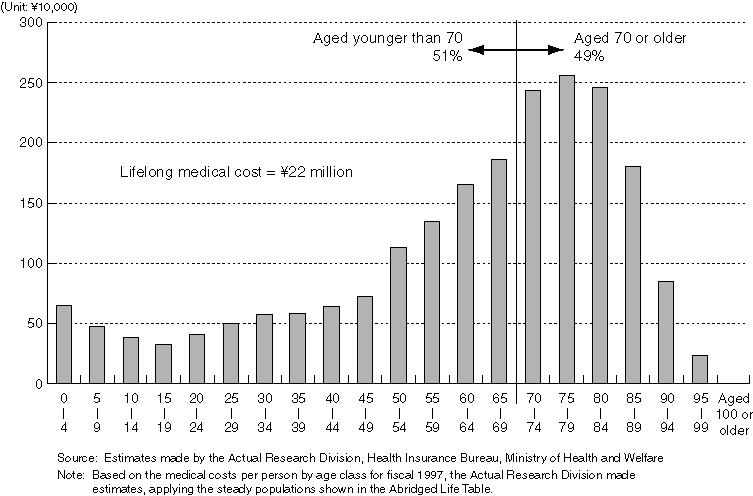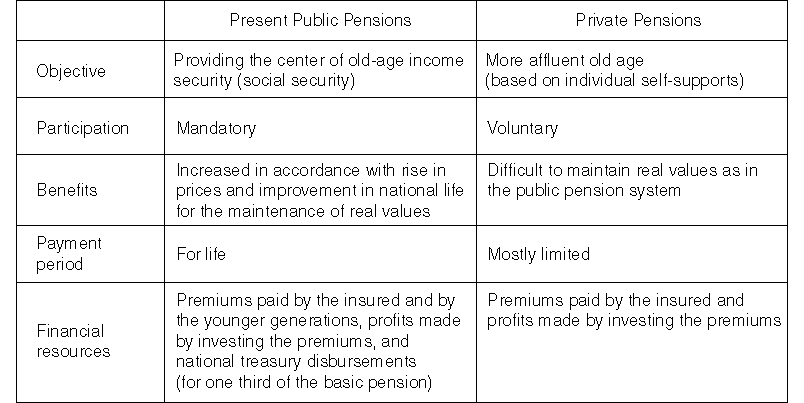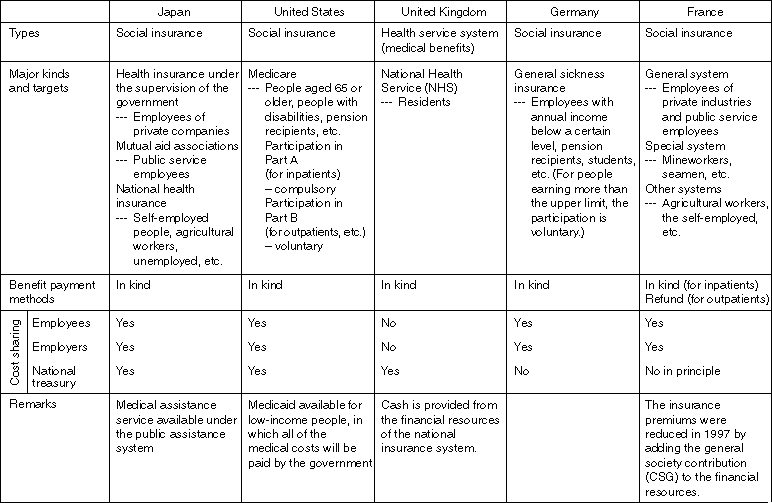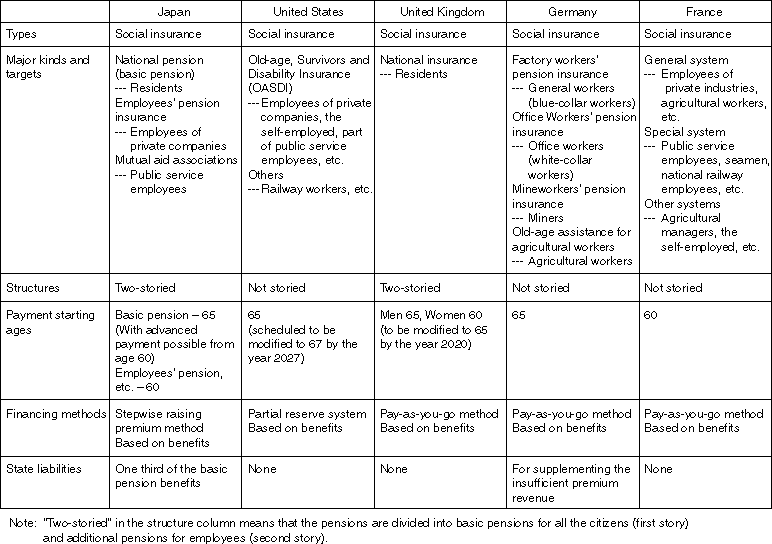

| INDEX | HOME |
| BACK | NEXT |
(Concept underlying social security)
The social security systems are created based on the agreement of the entire citizens and must be supported by each of the citizens to ensure sound and anxiety-free lives to every citizen in provision against any forms of instability in living without impairing his/her dignity. Mutual assistance and social solidarity of people support social security.
The basis of social security is comprised of mutual assistance and social solidarity: each member of society helps and supports each other. For example, there is mutual assistance within the same generation: the high-income class supports the low-income class, or the healthy support the ill. In the public pension system, the younger generations support the older generations. Besides social supports are given to mutual assistance within families and local communities. The target of social security benefits has been expanded to every member of society, and everyone shares the burdens to provide the financial resources for the benefits in forms of social insurance premiums and tax. Based on mutual assistance and social solidarity, the social security systems support the lives of other members of society and also help yourself and your family. The systems thus have two important aspects.
(Examples in the medical, pension and care systems)
For example, according to an estimate made in fiscal 1997, each citizen will spend about \22 million on medical services in his/her life (Figure 1-4-1). About half of the amount (\11 million) will be spent after the citizen attains his/her seventieth year. People tend to get ill when they become older and spend more on medical services. Depending on diseases, there is a possibility that a monthly medical cost including hospital charges will amount to \1 million or more. Without the present public medical insurance system, people would have to pay a lot of money for receiving medical services when they get ill and especially the lives of the elderly, who tend to get ill, would be unstable. Besides it is difficult for everyone to save enough money for paying the high medical cost. Even if you intend to save money in preparation against illness, you cannot predict how much you will have to pay for receiving medical services in your old age. Such savings will be inefficient for individuals and for the entire society.
Regarding income security for the elderly, according to the household surveys conducted by the Statistics Bureau of the Management and Coordination Agency, about 90% of the consumption expenditure (\230,000 on a monthly basis) is paid by public pensions in a household comprising an old couple without any jobs for 1998. Also in a household comprising a single person without any jobs, about 80% of the consumption expenditure (\110,000 on a monthly basis) is paid by public pensions. Under the present public pension system, pensions are provided for life after the start of the provision. For example, let us assume that a person qualified to receive employees' pensions retired from his job in 1997 at an average retirement age of 60. If the person dies at 81, living for another 21 years after the retirement, which is an average remainder of life after 60 as of 1997, he will be able to receive about \50 million as pensions (actually more than the amount, sliding as prices change). Besides if he dies leaving his wife, the wife will be able to receive survivors' pensions such as survivors' employees' pensions as a widow until she dies (for eight years on an average).
Without the present public pensions, what would happen? There would be only few who can save such a large amount of money while working. Besides it is impossible for anyone to predict how long he/she will live.Presently it is not rare for people to live as long as for 90 or 100 years. It would be almost impossible to save enough money in preparation for such long lives.
Figure 1-4-1. Lifelong Medical Cost (Estimated in fiscal 1997)

Just as before the establishment of the universal pension programs, could parents depend on their children? In the survey on the social security systems conducted in January 1999, the following question was asked to the working generations in their twenties to fifties. "To what extent could you bear the living expenses for your parents if employees' pensions (about \200,000 on a monthly basis at present) were not to be paid to them?"To this question, 30% of the respondents answered "I (or my brothers or sisters) cannot bear such expenses almost at all," and as many as 44% "I can bear only less than half of the amount presently provided as pensions." It is indeed difficult for children to give financial supports to their parents, and it would not be desirable or comfortable for old parents to depend on their children for their living.
The same may be said of the long-term care services. According to the Fiscal 1998 White Paper on National Life, the total cost for receiving average care services (one's own cost for receiving medical and welfare services plus cost of products required for care such as diapers) is less than \1 million for life for 70% of the entire population. It is, however, estimated that one out of ten persons will spend more than \5.7 million for receiving long-term care services. If everyone had to save more than \5.7 million for receiving long-term care services although the probability that he/she will require such services is not very high, the total amount of savings would be quite large. Such savings would restrict consumption and exert a negative influence on the entire economy.
The public long-term care insurance system to be introduced in April 2000 will provide measures for the entire society to deal with the risk of requiring long-term care. Under the system, even if you are in need of care, you can receive care services by bearing only 10% of the cost. The system will free people from worries about care, and will reduce the unnecessary savings caused by indefinable worries. If people use the savings for consumption, their lives will be enriched, which will eventually exert a good influence on economy.
(Rational and efficient mechanism)
Medical insurance and pension systems are effective for stabilizing people's lives actually in need of medical care or of income security in their old age. They free people from anxieties about the difficulties that cannot be dealt with by individuals or about the situations for which it is difficult to predict to what extent individuals can take measures.
Besides the systems provide a more rational and effective mechanism than private measures taken by the use of individual savings. For example, under the social insurance system, in provision against social risks, each one bears a burden in a wide range but in a small quantity based on the idea of social solidarity. In return, the person will receive considerable benefits when he/she gets ill or gets older, or when he/she can no longer earn money as before. Thanks to this mechanism, people do not need to save excessive money against social risks, or do not have to worry too much about the risks. Misunderstanding the idea of social solidarity behind the social insurance systems, some may think that they are paying social insurance premiums for the sake of others. The system, however, is actually quite helpful for themselves and their families.
2. Social Insurance and Social Assistance
(Mechanism of social security)
Social security can be provided by alternative methods under each of the social security systems: funded by social insurance premiums or by tax revenues; or in cash (as benefits) or in kind (as services).
Recently discussions were provoked about the method for funding the long-term care insurance system to be newly created: whether through social insurance premiums or by using tax revenues as financial resources.Besides some people argue that the percentage of tax revenues to be used as the financial resources for social insurance should be increased. The following paragraphs describe the outlines of social insurance funded by insurance premiums and of social assistance funded by tax revenues.
(Social insurance and social assistance)
The social security systems can be roughly divided into two types: those based on social insurance and those based on social assistance. Social insurance is established on the insurance expertise, and provides benefits funded by insurance premiums. In principle, the national government and other public organizations provide social insurance and the participation in the insurance programs is obligatory. The medical insurance system and the pension insurance system are the typical examples of social insurance.
Social assistance is not established on the insurance expertise, and is funded by tax revenues. The national and local governments provide cash or services to the citizens or residents as their social assistance measures. The public assistance system is a typical example of social assistance. Besides the social welfare programs for children, people with disabilities and for the elderly; child allowance; and welfare pensions are also included in social assistance. (Welfare pensions are given to people who are not covered by the universal pension program because they were already too old to participate in the program when the program was created.)
(Medical security and income security for old age mainly provided as social insurance)
In designing a social security system, the type of the system (social insurance or social assistance) is determined according to the aim and content of the system and to the historical changes in the environment.For social security systems in the world, systems for medical security and old-age income security are generally provided as social insurance such as medical insurance and pension insurance.
The Beveridge Report published in the United Kingdom in 1942 not only provided a basis for the designing of social security systems in the United Kingdom but also widely served as a basic reference material for the welfare countries including the United States and European countries. The Report proposed to position social insurance as the principal social security measures and to complement it with public assistance and voluntary insurance programs. Under the social insurance system proposed by the Report, each citizen would bear uniform insurance premiums and receive uniform benefits. Later such a system was institutionalized based on the National Insurance Act. The proposal was made based on the idea that social insurance, which would be universally provided to those contributing a certain amount of money, would be more suitable for free and independent individuals than social assistance that required status inquiries and was often associated with stigma.
The report made by the Advisory Council on Social Security in 1950 exerted influence on the establishment of Japan's social security systems. In the report, the Advisory Council also proposed to center Japan's social security systems on social insurance. The Council insisted that the government should not discourage people to take their own responsibilities and the center of social security should be the social insurance system that made the insured to bear the costs required for the maintenance of the system. Again in the report made in 1995, the Council emphasized the advantages of the social insurance system. Actually Japan's social security systems have been developed centering on the social insurance system, and about 90% of the social security benefit expenditure is paid through social insurance.
(Insurance principles)
Generally, insurance is a system for a group of people to provide against risks. A number of people who are exposed to a common risk form a group, and each member of the group pays insurance premiums in provision against future accidents. If one of the members meets with an accident, the person will receive an insurance benefit from the accumulated premiums to compensate for the damage.
For an insurance system to work effectively, the law of large numbers should be observed: a certain amount of people should gather and there must be a certain probability of accidents. Besides regarding insurance premiums and insurance money, the insurance system should be based on the following two principles. First, the total amount of premiums to be paid by the insured to the insurer should be equal to the total amount of insurance money to be paid by the insurer to the insured. Second, the amount of premiums to be paid by the insured should be equal to the amount of insurance money that may be paid to the insured in the future. The second principle implies that the level of insurance premiums to be paid by an individual will be determined based on the risks to be covered and the amount of insurance money that may be paid to the person.
(Differences between social insurance and private insurance)
The aforementioned principles generally apply to private insurance as well. Although social insurance is similar to private insurance in several aspects, there are also a lot of differences. For example, there are differences between the present public pensions and the private pensions (Table 1-4-2).
First of all, social insurance differs from private insurance in character. Unlike voluntary private insurance, everyone meeting certain conditions should participate in social insurance. Besides under private insurance, payments are made from insurance premiums and from profits made by investing the premiums, while social insurance ensures the payment of benefits and the maintenance of real values by price indexing adopted in the public pension system. Furthermore social insurance also contributes to income redistribution by reducing the insurance premiums for the low-income class or by the payment of benefits to the class.
Table 1-4-2. Differences between the Present Public and Private Pensions

There are also differences in terms of insurance principles. Under social insurance, the insurance premiums are not generally determined according to the risks to be covered. Instead, uniform, average premiums are collected, or premiums are collected according to the payment abilities of the insured (income, etc). Besides the employers of the insured, who are third parties (not the insured or his/her families to be directly covered by the insurance), bear some parts of the premiums. The benefits are often paid more than the level of insurance premiums paid. Social insurance thus serves as the mechanism for income distribution, which is not expected of private insurance.
Under social insurance, the balance between revenues and expenditures is often struck by the input of public money (tax revenues). This, however, dose not mean that the insurance principle has been altered. The diversification from the insurance principle has been caused because social insurance is mandatory and also targets the low-income class in need of social security measures. By inputting public money and reducing the insurance burdens on the low-income class, the social insurance system tries to make a homogeneous group of the insured from people who have income differentials. Besides public money is utilized for the national and local governments to fulfill their roles in social insurance, and reflects the policies for the stable management of the social insurance system and for the mitigation of the entire social insurance burdens.
Under the social insurance system, people pay insurance premiums to fulfill their duties for mutual assistance and social solidarity. In that the premiums differ from simple savings and private insurance premiums. By paying the premiums, however, just as in the case of private insurance, they obtain the right to receive benefits in the event that they meet with an event assumed under the social insurance system (getting ill for medical insurance or becoming old for pension insurance).
(Advantages and disadvantages of social insurance)
The social insurance method and the social assistance method have their own advantages and disadvantages.
The social insurance method has the following advantages. First, it has been made clear that the insured has the right to receive benefits in return for paying insurance premiums, and the right is stronger than the right provided under the social assistance method. Besides it is not a stigma to receive benefits: the recipient doesn't have to be ashamed for receiving them. Just like receiving medical services under the medical insurance system, people feel it natural to receive benefits under the social insurance system. Second, in terms of financial resources, because insurance burdens and the level of benefits are mutually related, the burdens are more easily accepted by the insured than in the case of taxes that are less related to each expenditure. Besides selfish demands such as "I want more benefits, but won't bear more burdens" can be avoided. The disadvantages of the social insurance method are the tendencies towards uniform, fixed types of benefits, and towards the abuse of benefits. The advantages of social insurance will be lost if the relationship between benefits and burdens is extremely weakened on an individual level.
(Advantages and disadvantages of social assistance)
The social assistance method has the following advantages. First, the method targets a wider range of people: people can receive benefits only if they meet certain conditions, regardless of whether they bear some burdens for receiving them. Second, the method can deal with specific needs in more detail. These advantages, however, tend to produce dependents on social assistance, or to increase fiscal expenditures. Besides to give benefits to people really requiring them, detailed status inquiries (surveys on income and assets called "means test") are made to put limitations on the income of people qualified to receive social assistance benefits.Besides the benefits are often limited depending upon family situations or fees for receiving social assistance services are decided according to the payment abilities of the recipients. For example, old-age pensions under the pension insurance system and medical benefits under the medical insurance system are provided regardless of how much the recipients are earning. However, child allowances and welfare pensions are provided only to those who meet the low-income requirements.
(Medical security systems and old-age income security systems of the major countries)
As analyzed in Chapter 2, the social insurance system has been playing an extremely important role in multiple aspects including financial resources in the expansion of Japan's social security benefits. Even in the United States where the idea of individual "self-support for independence" and "own responsibility" is given priority, old-age pensions and medical security for the elderly (Medicare) are provided as social security under a social insurance mechanism. A social insurance system obligates people to pay insurance premiums but at the same time entitles them to receive benefits. Based on the recognition of the duty and the right, people support each other in a spirit of social solidarity under the social insurance system, which is quite suitable for a modern matured society.
Finally, for reference, the medical security systems and pension systems of the major countries are internationally compared in Table 1-4-3. Social insurance systems differ by countries in terms of types, targets, benefit payment methods, contents of benefits, benefit levels, and the degree of state liabilities.
Table 1-4-3. International Comparison of Medical Security Systems and Pension Systems
(1) Medical security systems

(2) Pension systems

|